#distortion fuzz overdrive
Explore tagged Tumblr posts
Text
thrashin’ on pink ASD!
there’s a few left - if you’re interested in this weird, loud, noisy distortion pedal… message me!
#asd#pink#guitar pedal#distortion#overdrive#fuzz#noise#guitar#bass#handmade#trans music#support trans artists
13 notes
·
View notes
Text
youtube
NEW PEDAL DAY!! Help welcome another awesome creation from our friend Mark over at Summer School Electronics, the Class Reunion Overdrive Fuzz Distortion!! Combining elements of all your favorite effects genres, this one is a BEAST - head to YouTube to check out our demo NOW, cheers!!
#pedaloftheday#summerschool#summerschoolelectronics#classreunion#overdrive#overdrivepedal#fuzz#fuzzpedal#distortion#distortionpedal#guitarpedals#effectspedals#guitar#pedals#effects#knowyourtone#pedalsandeffects#guitareffects#pedalboard#guitarist#Youtube
5 notes
·
View notes
Text
How To Use - Top 5 Distortion and Overdrive Pedals
The Top 5 Distortion and Overdrive pedals you can buy easily, and just about anywhere. These are the some of the best drive tones you can purchase today. And not a boutique pedal in sight!
This list gives you what I believe are the most flexible, reliable, and readily available stompboxes. If you need a good overdrive or distortion for your guitar setup then this is the list for you and I’ve added a few basic tips to get the most out of each pedal. Ultimate Drive Tone? I have a huge collection of pedals myself and have been using pedals for over 35 years. This has given me some…
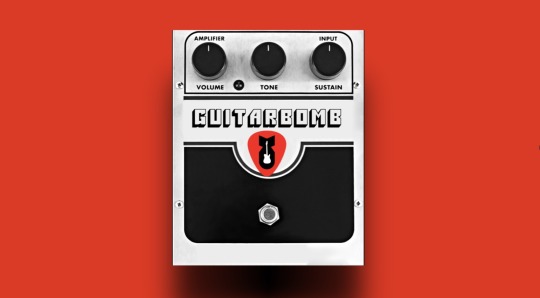
View On WordPress
#Booster#Boss#Boss BD-2 Overdrive#Boss DS-1 Distortion#Boss SD-1. Boss#diodes#distortion#fuzz#germanium diode#hard clipping#How To Use#How To Use these Top 5 Distortion and Overdrive Pedals#How To Use Top 5 Distortion and Overdrive Pedals#Ibanez#Maxon#MXR#MXR Distortion +#MXR Distortion Plus#Nobels ODR-1 BC#overdrive#pedal#preamp#ProCo#Proco Rat 2 Distortion#soft clipping#stompbox#Top 5 Distortion & Distortion Pedals#Top 5 Distortion Pedals#Treble Booster#TubeScreamer
0 notes
Text

Play.
#guitar#orange#marshall#fender#stratocaster#music#pedal#chorus#boss#reverb#fuzz#phase#distortion#overdrive
0 notes
Photo

The God’s Eye drive is the ultimate gain pedal #linkinbio #guitar #guitarist #pedalboard #overdrive #guitarpedals #music #fuzz #electricguitar #fender #guitarporn #distortion #guitarpedal #guitareffects #rock #metal #guitarplayer #stompbox #knowyourtone #geartalk #bass #pedals #pedalporn #effectspedals #pedal #musician #cleanboost #boss #stratocaster #gibson https://www.instagram.com/p/CouNIwzr8x2/?igshid=NGJjMDIxMWI=
#linkinbio#guitar#guitarist#pedalboard#overdrive#guitarpedals#music#fuzz#electricguitar#fender#guitarporn#distortion#guitarpedal#guitareffects#rock#metal#guitarplayer#stompbox#knowyourtone#geartalk#bass#pedals#pedalporn#effectspedals#pedal#musician#cleanboost#boss#stratocaster#gibson
0 notes
Text
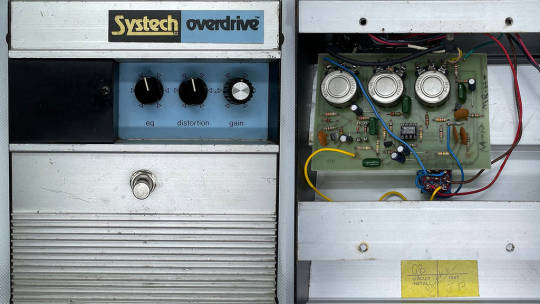
Systech - overdrive
"Have you ever played a pedal that stuck with you forever, even though you knew in your heart it was totally weird, and nobody famous ever used it? For me, yeah, tons of them. But if I had to pick one that best fit these criteria, this one would be it. This is the Systech Overdrive. Before we dive in, let’s talk a little about where it was made.
There was a time when, of all places, Kalamazoo Michigan was an epicenter for musically related things. Apart from being a city referenced by Looney Tunes and the hometown of Glen Miller’s gal, Kalamazoo had the Sound Factory, which was a collective of sorts that featured guitar luthiery, a recording studio and electronic gear manufacturing. The facility sat front and center on Kalamazoo Avenue, smack dab in the middle of the city, and attracted visitors from all over.
Of course, if it was some random outpost of nobodies, the name wouldn’t carry any weight. However, the Sound Factory was shored up by three relatively heavy hitters of the early ‘70s. One such was Greg Hochman, Keith Emerson’s Moog technician. He was joined by Bryce Roberson, otherwise known as Uncle Dirty of Chess Records fame and a relatively unknown person named Charlie Wicks. If you’ve been reading this column for a while, you’ll recognize him as the man behind ProCo—the Ratfather.
Together, these three developed Systech, which itself was short for “Systems & Technology in Music, Inc.” That mouthful of a company was responsible for the Harmonic Energizer, a little-known yet highly influential effect that provided a deep filtered sound in addition to some crunchy drive and sharp resonant peaks. You might know it as one of Frank Zappa’s signature pieces. And while this Overdrive effect wasn’t that, it was derived from the Harmonic Energizer and shares a handful of characteristics.
Basically, if dialed in just the right way, the Harmonic Energizer will make short work of an entire speaker cabinet and anyone in the audience. This is because it was designed to provide a staggering gain of 55dB, enough to cause serious damage to your gear or hearing. The Overdrive was created to get some of those tones at non speaker-shredding levels.
If you’re thinking this unit is some kind of proto-Tube Screamer, think again. Because this was the early ‘70s, nobody had really decided exactly what “overdrive” meant. And though Maestro (coincidentally, also in Kalamazoo) had created one of almost every effect under the sun, pedal fever wasn’t quite here just yet, so Systech was essentially “winging it.” With that said, the Overdrive is actually a pretty aggressive fuzz sound. And to that end, the fuzz circuit is pretty unique. The entire affair contains two transistors—one a JFET input buffer—and one dual op-amp with a handful of other components. Even the topology is relatively simple, but the simplicity ends with the schematic.
The EQ control works unlike pretty much any EQ control you’ve ever fiddled with; as much an EQ as the whole unit is an overdrive. Instead of a simple tonal adjustment, the EQ control is actually an active bandpass filter, in the same family as a wah circuit. With a simple twist of a knob, you can adjust this filter from 122Hz to 900Hz. As you might imagine, the EQ control sounds relatively cocked-wah-esque, but the sound is much more aggressive than any wah on the market before or since. The reason has to do with the Q factor, essentially a bandwidth control. A wah’s Q is set by its 33K resistor and is much wider than that of the Overdrive, so the tone is a little more rounded. While a wah’s filter is a rubber mallet, the Systech Overdrive’s is a tack hammer. While the sound is curious, the thing really comes to life when you crank the EQ control, as it gives you a nice punch in the mids. You lose a little definition when you get to the bottom third, but man is it fun to play with.
“Distortion” is just what it sounds like, but curiously enough, “Gain” is about as close to a volume knob as you’re going to get. Much like Distortion, if you turn it all the way down it kills the entire signal, but it sits behind a final gain stage. If you have the guts to crank both Distortion and Gain, you’re richly rewarded with gobs of gooey sustain, but the flipside is that your amp is likely screaming “uncle.” Worth it? Your call. I say go for it.
Many people say Zappa used a Systech Overdrive, but alas, he did not. However, when you play it, you can definitely see the similarities between this unit and the fabled Harmonic Energizer. But as far as I’m concerned, it’s close enough for rock and roll."
cred: catalinbread.com/blogs/kulas-cabinet/systech-overdrive
34 notes
·
View notes
Text
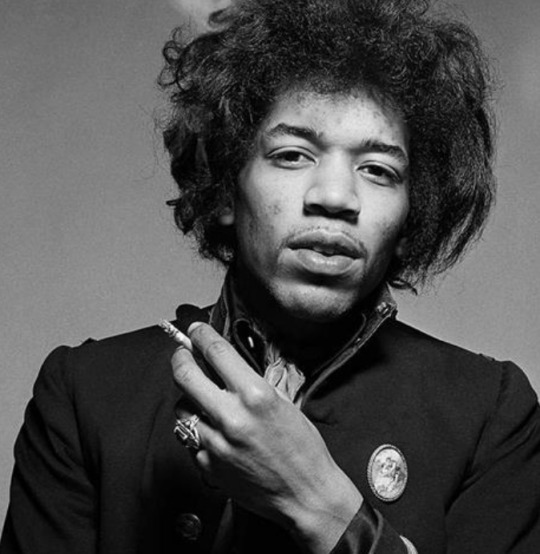
The 27 Club Part 2: Are You Experienced?
Three of the most revered Rock Musicians of the 1960’s all died within a year of each other, all at the age of 27. Their deaths shocked the world, and began the discussion of the disturbing phenomenon called the 27 Club. They were Janis Joplin, Jimi Hendrix, and Jim Morrison. Needless to say, their lives and talents could never be summed up in my few words.
Jimi Hendrix is widely regarded as the most influential rock guitarist of all time, despite not being able to read music. He first found work as a gig musician in Nashville, Tennessee, going on to work in the backing bands of artists like Little Richard, and the Isley Brothers. He moved to England and had a great deal of success with his band the Jimi Hendrix Experience. One of his most notable on stage performances came in 1969 when, on the third day of the Woodstock festival, when he played one of the most iconic renditions of the national anthem to a tired audience who had been rained on the night before. He died accidentally in 1970 due to barbiturate induced asphyxiation. After his death, his music and in particular his guitar playing was massively influential, as it led to the popularity of fuzz, gain, and overdrive as methods of sound distortion in rock records up until the present day.
3 notes
·
View notes
Text
Jonny’s Summer 2023 Guitar Pedalboard

Jonny about to stomp on a pedal during the Smile's show at Auditorio Nacional in Mexico City in late-June, 2023 (elamplimx).
With Radiohead, Jonny is known for very slowly adding pedals to his setup. While Ed often has half a dozen new pedals for a new album tour, Jonny often adds only one (such as his Headrush in 2000 or his Freeze in 2012). And when Jonny swaps out a pedal for a similar one (like one tremolo for another tremolo), it’s usually only when his old pedals are too worn out for touring (such as his original Whammy WH1 and vintage RE-201 Space Echos). One might think Jonny keeps the old pedals around because, since Kid A, he’s often playing other instruments. However, at live shows Jonny is still happy to replicate some recorded sounds on guitar, whether it be the filtered samples on Feral (using volume pedal, Whammy, and phaser) or the col lengo strings on Burn The Witch (using Whammy, overdrive, and a cello bow). It’s clear he enjoys getting the most out of those pedals in that specific arrangement.
But with The Smile, Jonny has been swapping in new pedals pretty regularly. In 2022, Jonny was experimenting constantly, sometimes adding new pedals for only a couple of days before swapping in a replacement. He quickly eschewed some of the Radiohead-favorites heard during the earliest Smile streams, such as his Small Stone, Tremulator, and OD3. In their place came flangers, compressors, and expression pedals: types of pedals he’d never used with Radiohead.
However, it seems like Jonny found a setup he was fairly happy with by the end of the fall 2022 tour. His latest live board is quite similar to the one used during March 2023 recording sessions for the band's upcoming second album, but even so there are a couple surprises!
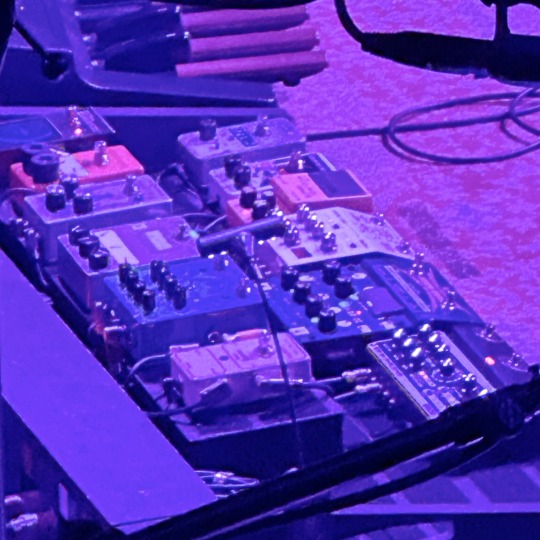
A photo of Jonny's guitar board at Philadelphia's Franklin Music Hall on July 8, 2023 (photo by Gio H.). He used this setup for the band's North American tour spanning 14 shows in June and July.
Guitar ->
Peterson StroboStomp HD tuner
MXR Dyna Comp compressor
EHX Freeze Sound Retainer
EHX Pitchfork pitch shifter
Boss SD-1 Super Overdrive
EQD Hizumitas fuzz
Telenordia/Tortenmann TA-24 Treble Booster
Boss DD-200 delay
Akai Headrush E2 delay/looper
Boss RE-202 Space Echo delay/reverb
EQD Pyramids flanger
Toadworks True Bypass (laptop send/return loop)
Lehle P-Split III signal splitter (A/B) <
(A) Radial JDI Stereo direct box < Radial Ch1 LOW-Z output -> FOH Mixer Radial Ch1 THRU output -> Fender ’65 Reissue Super Reverb
(B) Strymon Iridium -> Radial JDI Stereo direct box (Ch2 LOW-Z output) -> FOH Mixer
The small lamp over the board is a Mighty Bright HammerHead music stand light.
Jonny previously used a Peterson StroboStomp HD with his Sequential Circuits Prophet 5 on the Smile's 2022 tour. But this is the first time he’s been seen with one on his guitar board. It replaces the Boss TU2 he’s used since the earliest Smile shows.
The Telenordia Treble Booster is borrowed from Thom. The Telenordia is still marked with Thom’s guitar settings, from when he used it on You Will Never Work In Television Again during December 2021 rehearsals.
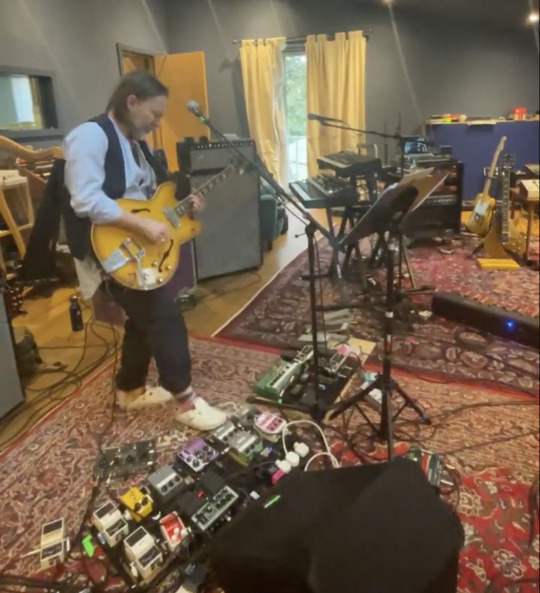
Thom stomping on Jonny's current Telenordia Treble Booster during a rehearsal on December 2, 2021 (youtube).
On Radiohead tours since OK Computer, Jonny has always brought a Vox AC30 — an amplifier well-known for its low and mid gain sounds. With an AC30, Jonny can get different flavors of overdrive by balancing between clipping from the pedal (using the pedal’s gain control) and clipping from the amp (using the pedal’s volume/boost control). And of course, he’d use his separate Shredmaster+Eighty-Five chain for heavy distortion on older songs.
But on tour with the Smile, Jonny has been using a Fender ’65 Reissue Super Reverb, an amp with much more headroom than the Vox thanks to a combination of higher wattage and negative feedback. As a result, we hear the overdrive pedal’s sound more clearly — the Boss SD1’s mid-rangy sound is especially noticeable on live versions of Thin Thing. So it makes sense that even Jonny would want to experiment with multiple dirt pedals for different flavors.
Jonny was first seen using an MXR Dyna Comp in a rehearsal photo, most likely taken when preparing for the fall 2022 tour (despite being posted in 2023). Thom and Ed have both previously used the pedal as well. Thom toured with a Dyna Comp only briefly before switching to his current Telenordia Kompressor. So it's interesting that Jonny first toured with a Kompressor (last year), but has gone the other way and switched to a Dyna Comp.
For those curious about the rhythmic delay setting marked on Jonny’s Akai Headrush E2, check out behind-the-scenes photos from The Smile’s Tiny Desk show. However, so far we’ve still only heard the pedal used as a looper.
Placing his Boss RE-202 after his Headrush allows Jonny to add ambient effects to his loops, as he does during the live outro of Skirting On The Surface.
Jonny first used a Strymon Iridium at a performance of Steve Reich's Electric Counterpoint at the Hidden Notes festival on September 25, 2022. For that show, it replaced his amp. But with the Smile, he’s using it as a backup for his Super Reverb.

A photo of Jonny's pedalboard from a November 2022 show in Anthem, DC (Facebook).
UPDATE: we originally listed the Telenordia TA-24 Treble Booster as a Telenordia TA-100 Overdrive. Thank you to Kayky for noticing!
#The Smile#Jonny Greenwood#Radiohead#Burn The Witch#Feral#You Will Never Work In Television Again#OK Computer#Skirting On The Surface#A Light For Attracting Attention#Thom Yorke#Ed O'Brien
45 notes
·
View notes
Text
Cirno 64 sound font demo
I think I finished my sound font. Can't quite distribute it due to copyright questions for a decent chunk of samples. But I compiled a demo of it. They're played in the order of the list at the bottom of the post. Feedback on the samples is welcome. ❤️
Playing is me mostly screwing around on my keyboard. I'm aware some of the sounds could use a release time, I need to figure out that part in sforzando. Conversely some of the samples from Kontakt have a few ms of silence before them which causes silence between back to back notes which isn't great e.g. the koto. There's also a weird wobble issue in the tanpura.
List of sounds
00-09: Keys
00: Grand Piano
State: finished ✔
Sample source: Kontakt
Redistribution: ❌
Possible replacement: ??? Regular grand piano.
01: Electric Piano
State: finished ✔
Sample source: Custom FM8 patch
Redistribution: ok Lush DX7-style electric piano sound reminiscent of that heard in Super Mario 64.
02: Church Organ
State: finished ✔
Sample source: Kontakt
Redistribution: ❌
Possible replacement: ???
03: Electric Organ
State: finished ✔
Sample source: Kontakt
Redistribution: ❌
Possible replacement: synth
10-19: Guitar
10: Acoustic Guitar
State: finished ✔
Sample source: Acoustic recording
Redistribution: ok Recording of an Ibanez acoustic guitar.
12: Clean Guitar
State: finished ✔
Sample source: Electronic recording
Redistribution: ok LP-style ESP guitar with a clean amp simulation.
13: Overdrive Guitar
State: finished ✔
Sample source: Electronic recording
Redistribution: ok Nicely driven guitar run through a Kuro T120, a pedal emulation of an Orange Matamp.
14: Distortion Guitar
State: finished ✔
Sample source: Electronic recording
Redistribution: ok ESP LP-style guitar into Dunwich Left Hand Path (a.k.a. Modified HM-2) and Nightowl Industries Parabellum Drive V1.
15: Chug Guitar
State: finished ✔
Sample source: Electronic recording
Redistribution: ok ESP LP-style guitar into Dunwich Left Hand Path (a.k.a. Modified HM-2) and Nightowl Industries Parabellum Drive V1. Same as Distortion Guitar but played muted.
16: Octave Fuzz Guitar
State: finished ✔
Sample source: Electronic recording
Redistribution: ok ESP LP-style guitar into a Dunwich Witchfinder octave fuzz, based on the Boss FZ-2 Hyperfuzz.
20-29: Bass
20: Ukulele Bass
State: finished ✔
Sample source: Electronic recording
Redistribution: ok Kala Journeyman U-bass.
21: Fingered Bass
State: finished ✔
Sample source: Electronic recording
Redistribution: ok Woodo X6 with flatwound strings and Nordstrand Big Blades.
22: Picked Bass
State: finished ✔
Sample source: Electronic recording
Redistribution: ok Woodo X5MS with stock setup.
23: Slap Bass
State: finished ✔
Sample source: Electronic recording
Redistribution: ok Woodo X5MS with stock setup.
24: Doom Bass
State: finished ✔
Sample source: Electronic recording
Redistribution: ok Woodo X6 with flatwound strings and Nordstrand Big Blades into a boosted Kuro T120 (Sunn Model T emulation)
25: Death Bass
State: finished ✔
Sample source: Electronic recording
Redistribution: ok Woodo X5MS into an Ibanez PD-7 pushing an Ampeg SVT-CL model.
26: Dark Bass
State: finished ✔
Sample source: Electronic recording
Redistribution: ok Woodo X5MS into a Darkglass Microtubes model.
30-39: Strings
30: Bowed Cello
State: finished ✔
Sample source: Electronic recording
Redistribution: ok NS Design WAV electric cello.
31: Pizzicato Cello
State: finished ✔
Sample source: Electronic recording
Redistribution: ok NS Design WAV electric cello.
32: String Ensemble
State: finished ✔
Sample source: Electronic recording
Redistribution: ok Layered and manipulated recordings of a NS Design WAV electric cello.
40-49: Wind
40: Trumpet
State: finished ✔
Sample source: VSCO
Redistribution: yes (CC0)
41: Ocarina
State: finished ✔
Sample source: Acoustic recording
Redistribution: ok Plastic chromatic ocarina.
42: Bottle
State: finished ✔
Sample source: Acoustic recording
Redistribution: ok Blown PET bottle.
50-69: Misc.
50: Sitar
State: finished ✔
Sample source: Kontakt
Redistribution: ❌
Possible replacement: ???
51: Tanpura
State: finished ✔
Sample source: Kontakt
Redistribution: ❌
Possible replacement: ???
52: Banjolele
State: finished ✔
Sample source: Acoustic recording
Redistribution: ok
53: Koto
State: finished ✔
Sample source: Kontakt
Redistribution: ❌
Possible replacement: ???
70-79: Synthesisers
70: Lead Synth
State: finished ✔
Sample source: Vital
Redistribution: ok Slightly percussive and moving synth.
71: Pad Synth
State: finished ✔
Sample source: Vital
Redistribution: ok Lush and layered pad synth running into a plate reverb model, inspired by https://www.youtube.com/watch?v=U5526pQUQaM
72: Synth Choir
State: finished ✔
Sample source: ZynFusion
Redistribution: ok Choir preset.
73: Fantastic Synth
State: finished ✔
Sample source: Vital
Redistribution: ok Imitation of the lead synth heard in Necrofantasia.
74: Eurobeat Brass
State: finished ✔
Sample source: Vital
Redistribution: ok Pretty standard Eurobeat Brass, per https://www.youtube.com/watch?v=eJsFlyzpCDM
75: Sine Bass
State: finished ✔
Sample source: ZynFusion
Redistribution: ok Plain sine wave. Popularly used in Jungle / Drum & Bass.
76: 808 Bass
State: finished ✔
Sample source: Vital
Redistribution: ok 808-style bass synth.
80-89: Percussion
80: Drum Kit
State: finished ✔
Sample source: Superior Drummer
Redistribution: ❌
Possible replacements: DrumGizmo kits
81: Pitched Gong
State: finished ✔
Sample source: Acoustic recording
Redistribution: ok
82: Glockenspiel
State: finished ✔
Sample source: Acoustic recording
Redistribution: ok
83: Frog Guiro
State: finished ✔
Sample source: Acoustic recording
Redistribution: ok
4 notes
·
View notes
Text
I think fuzz is a better distortion effect than overdrive..
3 notes
·
View notes
Text
20 years of Effects Database!
20 years ago I started a little site called "DiscoFreq's Envelope Filter site" as there were no overviews listing more than 20 envelope filters. After the envelope filters, I added other types of filters (including synth modules), then octavers, ring modulators, vocoders, talkboxes, fuzz pedals, phasers, flangers,... until I decided to add ALL pedals, including the hundreds and hundreds of distortion and overdrive pedals. From the beginning, it was very important to me to include all the small builders, a lot of which only had a presence on eBay and forums like Harmony-Central.
A lot of those early brands disappeared and many of the "big" brands now didn't even exist yet. I've seen several "waves" of pedal builders since (the next one was in 2007-2008, "helped" by the financial crisis at the time), a lot of Musikmesse (RIP) and NAMM shows and a lot of other changes (YouTube didn't exist in 2003).
I can't really make a big celebration of this anniversary right now as the last few years I had to slow down (divorce, moving a few times, evening course,...) and focus on keeping the site running, adding the new videos,... I did see the new brands and pedals and added many hundreds of each in a queue, but I couldn't keep up adding them. I'd like to catch up again soon and finally give the site a big overhaul as well (there were previous attempts, but no results...).
I always had lots of plans and ideas, some of which have since been done by others like a similar site about synth modules, a system to "switch" pedals on/off in audio demos (working prototype for about 10 years),... As I did it all on my own and in my spare time with very limited resources, I didn't really manage to add everything I want/wanted. I had lots of work just to keep it running and growing in the existing format, so I'm still interested in help from others, this really should be a community effort. Help is very welcome with content, development (also for a related Raspberry Pi idea I have for years!) and sponsorships/advertisers (currently carrying a big part of the costs myself).
That way I hope we can add many more years to this site and celebrate the next big birthday
Cheers!
Bart / DiscoFreq
read more
from Effects Database https://bit.ly/3BTEEfY
8 notes
·
View notes
Text


took some nicer pics of ASD in pink.
there’s like 3 left, available via dm.
ASD is a boost & overdrive combo circuit that will take your tone from crunchy drive, to fat distortion, all the way to blown-out fuzz noise! Great for both guitar & bass!
6 notes
·
View notes
Text
Distortion Plugins: What Every Musician Needs to Know

Distortion plugins have been a mainstay in the world of music production for decades. But what exactly are they, and why are they so important? In this blog post, we'll take a look at what distortion plugins are, how they work, and why you should consider adding them to your music production toolkit.
How Do Distortion Plugins Work?
Distortion plugins work by taking the input audio and modifying it in various ways. This can involve amplifying the audio and then "clipping" the sound waves to create a distorted effect. Some plugins use digital algorithms to create this effect, while others use analog-style circuits to emulate classic distortion sounds.
Why Are Distortion Plugins Important?
Distortion plugins are important for a number of reasons. First, they allow you to add character and texture to your audio recordings, making them sound more interesting and dynamic. This can be especially useful for rock and metal music, where distortion is a staple of the genre.
Second, distortion plugins can help to bring out the best in your audio recordings. By adding subtle distortion effects, you can add definition and clarity to your audio, making it easier for listeners to hear what's going on. This is especially useful when recording live music, where the sound of the audience can get lost in the mix.
Third, distortion plugins can be a lot of fun to play with! Whether you're a seasoned producer or just starting out, experimenting with different distortion sounds can be a great way to get creative and come up with new ideas.
Types of Distortion Plugins
There are many different types of distortion plugins available, each with its own unique sound and capabilities. Some of the most popular types include:
Overdrive plugins: Overdrive plugins add a subtle distortion effect to audio recordings, giving them a warm and crunchy sound.
Saturation plugins: Saturation plugins add a similar effect to overdrive plugins, but with a more subtle and rounded sound.
Distortion plugins: Distortion plugins add a more pronounced distortion effect to audio recordings, making them sound louder and more aggressive.
Fuzz plugins: Fuzz plugins add a heavily distorted effect to audio recordings, making them sound like they're being run through a vintage fuzz box.
Choosing the Right Distortion Plugin
With so many different distortion plugins available, it can be hard to know which one is right for you. Here are a few things to consider when choosing a distortion plugin:
Sound: What type of sound are you looking for? Do you want a subtle overdrive effect, or are you after a more aggressive distortion sound?
Compatibility: Does the plugin work with your music production software? Some plugins are only compatible with certain DAWs (digital audio workstations), so be sure to check before you buy.
Price: How much are you willing to spend on a distortion plugin? There are many affordable options available, but some high-end plugins can be quite expensive.
In conclusion, distortion plugins are an essential tool for any musician, offering a wide range of creative possibilities and helping to bring the best out of your audio recordings. Whether you're a seasoned producer or just starting out, be sure to give them a try!
2 notes
·
View notes
Text
Effects unit

A guitar pedalboard allows a performer to create a ready-to-use chain of multiple pedals to achieve certain types of sounds. Signal chain order: tuner, compressor, octave generator, wah-wah pedal, overdrive, distortion, fuzz, EQ and tremolo.
""An effects unit, effects processor, or effects pedal is an electronic device that alters the sound of a musical instrumentor other audio source through audio signal processing. Common effects include distortion/overdrive, often used with electric guitar in electric blues and rock music; dynamic effects such as volume pedals and compressors, which affect loudness; filters such as wah-wah pedals and graphic equalizers, which modify frequency ranges; modulation effects, such as chorus, flangers and phasers; pitcheffects such as pitch shifters; and time effects, such as reverb and delay, which create echoing sounds and emulate the sound of different spaces. Most modern effects use solid-state electronics or digital signal processors. Some effects, particularly older ones such as Leslie speakers and spring reverbs, use mechanical components or vacuum tubes. Effects are often used as stompboxes, typically placed on the floor and controlled with footswitches. They may also be built into guitar amplifiers, instruments (such as the Hammond B-3 organ), tabletop units designed for DJs and record producers, and rackmounts, and are widely used as audio plug-ins in such common formats as VST, AAX, and AU. ..."
W - Effects unit (Audio)
0 notes
Link
Unleash the chaos with the EarthQuaker Devices Gary, a fuzz-overdrive inspired by Idles. Perfect for creating raw, distorted soundscapes
0 notes
Text


Lemon & Ginger - FuzzMan 1st
"... octave fuzz pedal. This pedal was created to be used in combination with other overdrive pedals, distortion pedals and fuzz pedals. Generally, fuzz pedals are placed at the front of the pedalboard. However, Fuzzman does not. This pedal can be controlled DRY and WET with the pedals in front of it by moving the BALANCE. So the best position for this pedal is just behind the distortion section. But if you want more bass, put it at the front and boost it with the pedal behind. You will get a tone like SRV or KWS."
cred: lemon-and-ginger.com/products/fuzzman-1st
7 notes
·
View notes